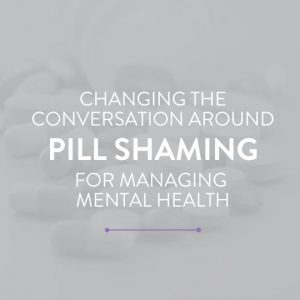
We are not our trauma. We are not our brain chemistry. That's part of who we are, but we're so much more than that."
- Sam J. Miller
Small changes in language make an immeasurable difference. Shifting to person-centered language decreases stigma and creates safer space for open conversation about mental health in every environment––including your workplace.
Your words matter.
I get it––talking about mental health and mental illness can feel like you’re stepping into a linguistic minefield, never sure if there’s a right or wrong thing to say or way to talk about it.
It’s a huge barrier and a hard space to navigate unprepared. The good news is two-fold:
- We can do hard things (thank you, Glennon Doyle); and
- You can prepare with specific tools and strategies
Let’s do both of those things inside this blog.
TO CORRECT OR NOT CORRECT: THE CURRENT PERSON-CENTERED LANGUAGE DEBATE
Last year, speaker, mental advocate, author Natasha Tracy published a piece titled “Stop ‘Correcting’ Mental Health Language on Healthy Place.com. The crux of her argument is this:
“People feel the need to ‘correct’ mental language constantly. This is mainly a product of political correctness and virtue signaling––both of which I detest. … Wrong mental illness name––boom––you’ve exploded. Wrong sentence structure––boom, you’ve exploded again.”
The concern here? That “… running circles around correctly mental health language simply shuts down the conversation altogether, and that’s the exact opposite of what mental illness needs.”
Both Tracy and myself have clinical diagnoses for different mental health disorders. We are allies with the same mission: Open safe conversations about mental illness to end stigma. But we have different ways of talking about our own experiences that feel right to us. And although we share a vision to end stigma and create safe spaces for open dialogue about mental health and mental illness, we have different opinions about the best ways to actuate that vision.
I will always stand for inclusive, non-stigmatizing language. I believe how one chooses to identify or talk about their own experiences is not anyone’s place to “correct”––but I also believe being mindful and conscious in our own word-choices when speaking about other people and their experiences is instrumental in reducing stigma.
I believe in the evolution of language and the science behind why words matter.
What is that science? I’m glad you asked.
HOW WORDS HURT
Generations of people grew up in societies where “loony”, “psycho”, “schizo” and “crazy” were not only a part of their everyday language but acceptable as part of their everyday language.
But language evolves. Today, those terms are outdated and dangerously stigmatizing.
As linguist Valerie Fridland, Ph.D wrote in Psychology Today: “… ‘each word has its own history.’ While we often use words without knowing … broader histories, that doesn’t mean this history is forgotten by all, or that our positions relative to this history will be the same.”
In lay-person’s terms, our brains respond to words without even realizing it.
But if you haven’t experienced a particular history, it’s not entirely instinctual to perceive how another person internalizes a word or an expression.
If you have never experienced a mental health crisis or lived with mental illness, it may not instinctually occur to you that specific words or phrases may cause someone real harm. That’s not a criticism––it’s a true and judgment-free statement.
The science behind language breaks down like this: When we hear words, the emotional part of our brains undergoes what scientists and psychologists call “associative activation” which describes the cascade of brain activity that happens when we see or hear a word––that word “brings an idea, and an idea triggers many other ideas … [and we keep] making connections between all those ideas by resurfacing memories, which in turn recall emotions, that then bring other reactions.”
In lay-person’s terms, our brains respond to words without even realizing it.
THINGS TO AVOID SAYING (AND WHAT YOU SHOULD SAY INSTEAD)
Imagine a conversation happening around the water cooler at your company. Imagine your employees casually talking about Adam, an employee who recently took leave for alcohol misuse disorder. And imagine hearing them say “did you hear about Adam? He totally lost it–– that psycho alcoholic just checked himself into the loony bin.”
Now … imagine that same conversation went something like this:, “I am so proud of Adam. I’m so glad he felt safe enough to talk about his alcohol misuse disorder and accessed help. I’ll do anything I can to support him and his return to work.”
And maybe someone else says, “Yeah. Because of him, I feel like I can talk about the stress and anxiety I’ve been feeling and see if management can offer me resources, too.”
Now: Which workplace would you be proud to lead?
The challenge is getting employee buy-in on mental health initiatives in your workplace so they can put this inclusive, person-centered language into practice.
Change is hard, and change is scary. You might get some push-back. Ultimately, however, It’s your responsibility as a business owner or C-suite executive to lead by example. An immediate action is a conscious decision to embrace person-centered language in your own conversations in your workplace, and your life.
3 Key Elements of Person-Centered Language
Here are three key elements of person-centered language that creates a sense of safety for everyone involved in the conversation:
- Focus on the person, not the condition. A mental health condition (or physical or other condition) is only one aspect of a person’s life, not the defining characteristic.
- Preferred: She is a person with bipolar disorder.
- Not preferred: She is bipolar.
- Be specific. Mental illness is a general condition. Specific disorders are types of mental illness.
- Preferred: He was diagnosed with bipolar disorder
- Not preferred: He was mentally ill
- Avoid derogatory or victimizing language. Avoid terms like “psycho”, “crazy” or “junkie”, and words like “suffering” or “victim” when talking about mental health conditions.
- Preferred: She has substance misuse disorder.
- Not preferred: She’s a drug addict
- Preferred: She is a person with depression.
- Not Preferred: She suffers from depression.
DO THE HARD THING: CHANGE YOUR WORKPLACE CULTURE AROUND MENTAL HEALTH
People living with mental health conditions might choose to talk about it in different terms. Some people might identify as someone living with a mental health condition or mental health diagnosis, while others prefer to say they have a mental health challenge or needs, or a mental health disability.
The important takeaway is that people are more than physical, mental or other conditions. And that’s the guiding light for re-shaping your language.
One commenter on Tracy’s article shared their own standard operating procedures for talking about mental health and mental illness when she wrote:
“I don’t correct the person [with lived experience.] I do correct people talking about another person.”
This is really what it’s all about as you work to create a mentally healthy workplace culture, one in which your employees feel safe, secure and comfortable talking about mental health challenges.
But it doesn’t stop with person-centered language. Elevating your workplace culture and creating a safe, inclusive environment doesn’t just help individuals––it helps your bottom line because happier, healthier people are more productive employees.
If you want to do things like:
- Reduce employee turnover
- Decrease absenteeism
- Reduce workplace injuries
- Increase productivity
- Boost employee morale
Then explore the customized 4 Pillars of Creating a Mentally Healthy Workplace training program built exclusively for leaders who want to create a culture where everyone feels ‘safe’ speaking openly about mental health. The most powerful organizations empower employees to remove the mask of fear and shame and step forward to say, I’m not ok and I need help.”
A positive workplace culture embraces inclusivity and compassion, and celebrates individuals for their talents and contributions.
Leaders have the power to transform the workplace culture. Be the pillar your employees deserve and simultaneously support your own mental health.
Become the leader people clamor to work with–– create a workplace culture people love to be part of everyday.
Ask me how I can help you.

You are invited to schedule a consult to learn how to shift the dialog about mental health and create a mentally healthy workplace culture where everyone feels safe asking for help.




